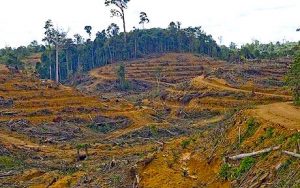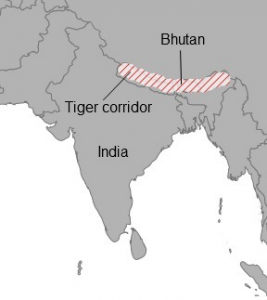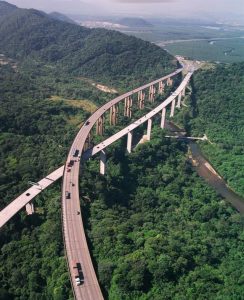Habitat fragmentation is a term describing the process by which a large habitat is broken up into numerous smaller habitats of decreased area and size, separated by a matrix of new unfamiliar habitat types – driven by the action of habitat loss (Didham, R.K., 2010). The loss of habitat through fragmentation is thought to be one of the main drivers of global biodiversity loss and can be either naturally occurring (climate change, volcanism, fires etc.) or human induced.
“70% of remaining forest is within 1km of the forest edge..” (Haddad et al, 2015)

What are the major effects of habitat fragmentation?
A long term global forest fragmentation study revealed that decreases in fragment area and an increase in fragment isolation, generally causes a drop in the abundance of:
- Mammals
- Birds
- Insects
- Plants
In tropical forests, reduced fragment sizes led to an increase in the portion of edge habitat exposed to unfamiliar surroundings. Following the increase in edge habitat, a shift in the physical environment was observed which caused a subsequent loss in the oldest and largest trees from these fragments, which had knock-on impacts on the wider community and specifically insect community compositions (Haddad et al, 2015).

Fragmentation also effects communities through alterations of predator-prey interactions. It has been theorised that specialist predators are affected more severely by the fragmentation than their prey leading to a lower specialist predator abundance (Ryall & Fahrig, 2006). Generalist predators whom live predominantly within the matrix are thought to be benefited by increased fragmentation, so long as the new matrix is able to provide the generalist predator with alternative resources (Ryall & Fahrig, 2006). These adjustments will have cascading effects down through communities due to a rise or fall in the populations of top predators and their prey.
What is being done to help?
Case study: The Bhutanese Tiger corridor
One mechanism that has been implemented around the world is the use of ‘wildlife corridors’ (Silveira et al, 2015), which serve to reconnect fragmented patches of habitat. The Bhutanese Tiger corridor, from Northern India into Bhutan (see figure 2) has proven that this method does work. The corridor connects isolated Tiger habitats that now allow free passage for Tigers and other community species across a far greater space of land. Since its introduction the Bhutanese Tiger population has risen by more than a third of its previous population estimate.

Fragmentation induces diverse changes that progressively filter through ecosystems. It considerably lowers species richness of both plants and animals and in many cases it has impacted the structure and make up of entire animal communities. Habitat fragmentation is therefore an extreme threat to virtually all terrestrial biodiversity. Consequently, conservation efforts and habitat restoration projects must being immediately in order to prevent catastrophic losses and extinctions of some of the most iconic species on earth.
[Word count: 499]
References
- ALERT, (2017). Forest fragmentation in the tropics.. [image] Available at: http://alert-conservation.org [Accessed 21 Mar. 2017].
- Broad, M. (2012). NE Indian Tiger corridor. [image] Available at: http://pictures-of-cats.org/the-tigers-of-bhutan.html [Accessed 20 Mar. 2017].
- Didham, R.K., 2010. Ecological consequences of habitat fragmentation. eLS.
- Fahrig, L., 2003. Effects of habitat fragmentation on biodiversity. Annual review of ecology, evolution, and systematics, 34(1), pp.487-515.
- Haddad, N.M., Brudvig, L.A., Clobert, J., Davies, K.F., Gonzalez, A., Holt, R.D., Lovejoy, T.E., Sexton, J.O., Austin, M.P., Collins, C.D. and Cook, W.M., 2015. Habitat fragmentation and its lasting impact on Earth’s ecosystems. Science Advances, 1(2).
- Ryall, K.L. and Fahrig, L., 2006. Response of predators to loss and fragmentation of prey habitat: a review of theory. Ecology, 87(5), pp.1086-1093.
- Silveira, L., Sollmann, R., Jácomo, A.T., Diniz Filho, J.A. and Tôrres, N.M., 2014. The potential for large-scale wildlife corridors between protected areas in Brazil using the jaguar as a model species. Landscape ecology, 29(7), pp.1213-1223.


Recent Comments